1. Tomb-chapel of Ipay

In 1996, a joint project of Waseda and Tokai Universities started and the new site at Dahshur North was identified through computer analysis of satellite imaging data; we applied the world's first satellite remote sensing technology to archaeology. Subsequently, we discovered a previously unknown New Kingdom necropolis at a low mound approximately 2 km north of the Red Pyramid of Snefer. The importance of this is that a New Kingdom necropolis was discovered at Dahshur area for the first time, where only Old Kingdom and Middle Kingdom necropolis had been known.
The necropolis is composed of the tomb-chapels, shaft-tombs and simple burial-pits. On the southernmost hilltop, a large free-standing tomb-chapel comparable size to the famous one of the general Horemheb at Saqqara was discovered, though only the foundation bricks of the superstructure were preserved. Some stamped mud-bricks suggest that the tomb-chapel was built for “Ipay, royal butler and royal scribe.” The tomb consists of a ramp, two courts, a cult chapel, and a deep rectangular shaft leading to subterranean chambers at center of the second court. The superstructure was originally constructed with the mud-bricks and limestone revetment, which is similar to the tombs of Horemheb and Maya at Saqqara. The shaft is revetted with the thirteen courses of limestone blocks in a standard size of 52 x 26 x 22 cm, which corresponded to the so-called talatat. From these architectural features, the tomb of Ipay is thought to be dated to the late Eighteenth Dynasty.
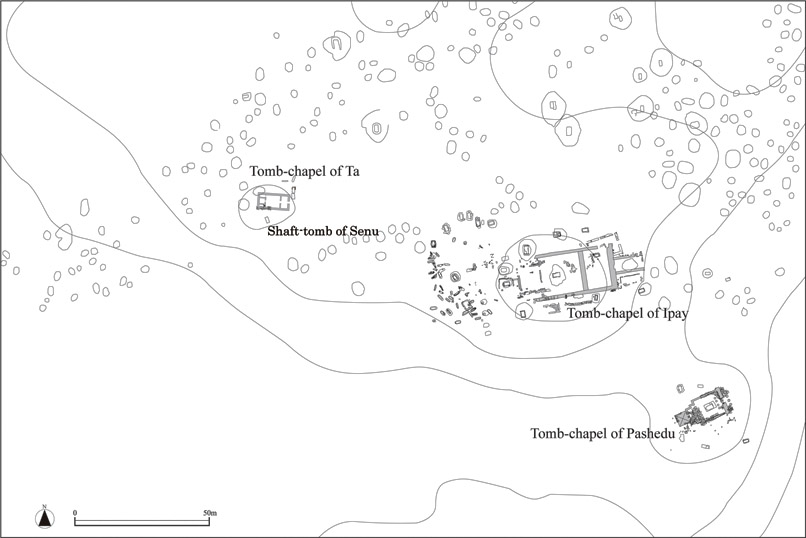
Site map |
Although remain of Ipay’s burial was not found in the subterranean chambers, a large number of objects have been collected. A number of limestone blocks with sunken relief were unearthed at the bottom of the shaft. Probably, these relief blocks had originally decorated the walls of the superstructure. From the style and shape of motifs, relief blocks can be dated to the Post-Amarna period.
A number of fine funerary objects were also found in the subterranean chambers, including faience rings with the name of Tuthankhamun and Ankhesenamun, two scarabs bearing the name of Rameses II. A same shape group of gray faience shabtis inscribed with the names of Pashedu, Amenemopet and Huy suggests multiple burials or a continual use of the Ipay’s tomb.
The most remarkable find was a granite sarcophagus, measuring 2.8 m in length, in the innermost chamber. The inscriptions on the sarcophagus and jar dockets suggest that its owner is "Mes, Royal scribe and Steward" in the reign of Rameses II. One large sandstone shabti of Mes was uncovered beside the sarcophagus. It wears a Nubian wig and long kilt with its surface painted brown.
Many shaft-tombs are distributed around the tomb of Ipay. Clearance of these shaft-tombs has also yielded elaborate funerary objects, including a complete faience broad collar, a funerary scarab with figured scenes, golden finger ring with a carnelian Wedjat-eye, and so on.
To the south of the tomb of Iapy was the New Kingdom tomb-chapel belonging to Pashedu (different from the man who was found in Ipay's tomb). Although the superstructure is totally collapsed, the mortar traces on the floor suggest that the plan measures 21m x 10.5m, and
consists of an portico with columns, an pylon gateway, a courtyard with shaft, three offering chapels and a pyramid at the rear, which were all constructed in limestone. The substructure led by the shaft is composed of five chambers. The inner most burial-chamber has a sarcophagus-pit which was cut in the floor and divided into two by reveted slabs. The sarcophagus-pit was totally empty by robbery. From debris, however, there were found relief fragments with the name of Pashedu and quartzite fragments from his statue and pyramidion.
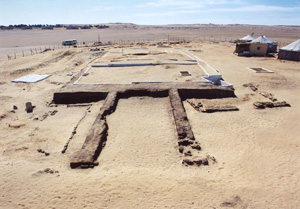
Tomb-chapel of Ipay, looking from East |
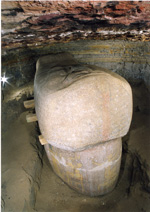
Sarcophagus of Mes |
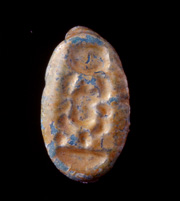
Ring of Tuthankhamun |
2. Tomb-chapel of Ta

Since 2004, a new area has been investigated at a small mound approximately 100 m to the west of Ipay’s tomb. In excavating the small mound, it proved to be a typical New Kingdom tomb-chapel built of limestone with a shaft in the center of its courtyard, although the superstructure had been totally destroyed. The tomb-owner could be identified from the inscriptions on relief blocks and funerary objects as “Ta, wab and lector priest of Ptah”. Among the finds, the most conspicuous were relief blocks with a scene depicting a group of gods on a solar boat (ca 3.5m in width). At the center is ram-headed Ra with Uraeus in the sun disk, along with Isis, Thoth, and Maat at the front, Nephthys and a falcon-headed god at the rear. On this scene, are represented Keper with wings above Ra, two gods coming out of the sky and helping sail the boat, a child sitting on the bow of boat, and two baboons worshipping a sun disk on the cavetto cornice, all of which points to a characteristic representation of a “night-bark” just before daylight.
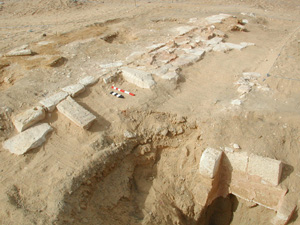
Floor remains of Tomb-chapel of Ta |
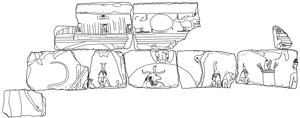
Relief fragments depicting
a solar boat |
3. Middle Kingdom rectangular coffins

In subsequent seasons, the investigations around the tomb-chapel of Ta revealed many tombs not only of the New Kingdom but also of the Middle Kingdom, previously unknown in this area. In 2005 there was a discovery of the Middle Kingdom intact tomb belonging to an individual named Senu. His burial was found in a shaft located under the tomb-chapel of Ta. A rectangular coffin was found at the bottom of the shaft. This coffin was fully painted in yellow, with text columns in blue. The inscriptions include the title and name of the owner, “the commander, Senu”. The content and layout of the text clearly date to the Middle Kingdom. Inside the coffin, there was a linen wrapped mummy wearing a cartonnage mask. The mask has features such as a false beard of wood, a blue modeled wig, and a polychrome broad collar, all of which are characteristic of a Middle Kingdom coffin.
In 2007, more two intact rectangular wooden coffins were excavated from two burial chambers located to the north and south of the shaft respectively They date from the 12th to 13th Dynasties in the Middle Kingdom approximately the same time as the previously found burial of Senu, and the shaft is located just to the east of Senu’s tomb. From the inscriptions on the coffin, the names of the individuals interred were Sobekhat and Senetites, who seems to have been husband and wife. Sobekhat, believed to be the husband, held the title of “Funerary Priest,” a position whose duties would have included conducting prayers and making offerings for the deceased.
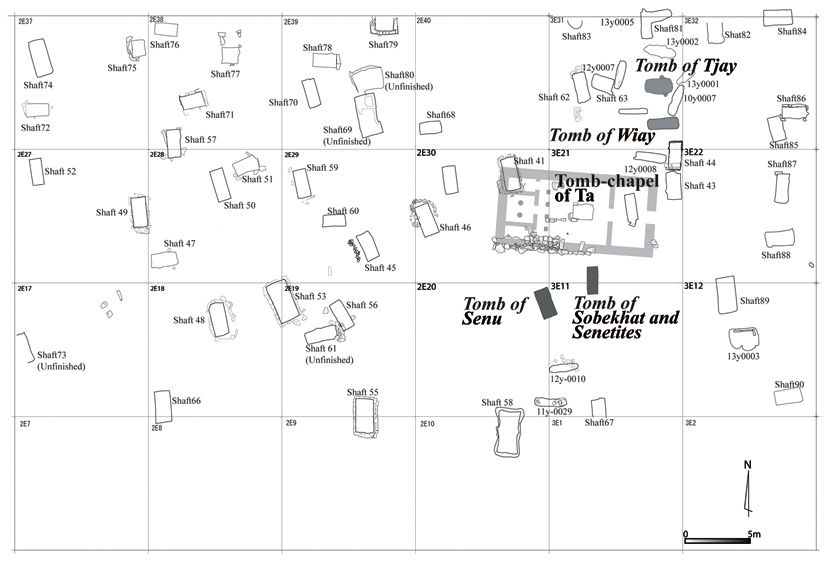
Intact tombs around the tomb of Ta |
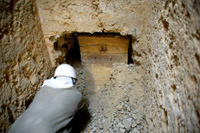
Coffin of Senu, in situ |
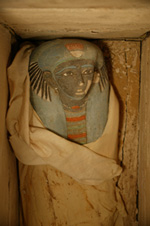
Mask of Senu |
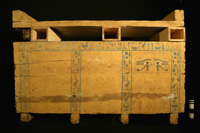
Coffin of Senu |
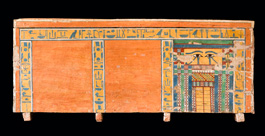
Coffin of Sobekhhat
|
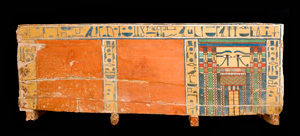
Coffin of Senetites
|
4. New Kingdom anthropoid coffins

Furthermore, the excavation in 2007 revealed two more intact tombs, from which unopened wooden coffins were recovered respectively. Both tombs were simple pit-burials in the one of which a black-painted anthropoid wooden coffin of an individual named Wiay dating to the late Eighteenth Dynasty was found. From the inscription on the surface of the coffin, it appears that he bore the title of “Chief Craftsman at the Temple of Amun”, where he was probably in charge of supervising craftsmen.
The other tomb was located just to the north of the burial of Wiay. One mummy was found laid out in an undisturbed and unopened black, wooden anthropoid coffin. Inscriptions on the sides of the coffin indicate that the name of the individual inside was Tjay and the title was “craftsman.” There were also images of two pyramids found at the foot of the coffin. From this it is estimated that the individual was a building engineer who was engaged in the construction of temples and pyramids. In the south side of the tomb, the mummy of a child was discovered in a rectangular wooden coffin painted in yellow. This child must have been a son of Tjay. In any event, Tjay and Wiay presumably lived in the same period and had a very close relationship. Their relationship and other details will merit further research.
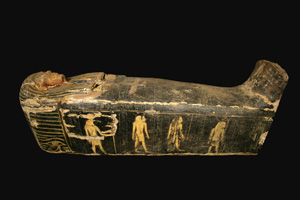
Coffin of Wiay |
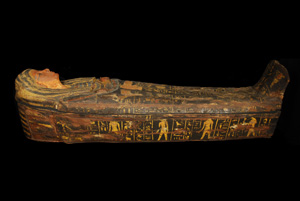
Coffin of Tjay |
Bibliography

Yoshimura, S., Kondo, J., Hasegawa, S., Sakata, T., Etaya, M., Nakagawa, T. and Nishimoto, S.
1997 ‘A Preliminary Report of the General Survey at Dahshur North, Egypt’, Mediterraneus: Annual Report of
the Collegium Mediterranistarum XX, pp.3-24.
Yoshimura, S., Kondo, J., Hasegawa, S., Nakagawa, T., Nishimoto, S., Kashiwagi, H., Sakata, T. and Etaya, M.
1998 ‘Preliminary Report of Excavations at Dahshur North, Egypt-1st and 2nd Field Seasons-’, Mediterraneus:
Annual Reportof theCollegium Mediterranistarum XXI, pp.3-32.
Yoshimura, S. and Hasegawa, S.
1999 ‘A Ramesside Sarcophagus at Dahshur’, Egyptian Archaeology 15, pp.5-7.
Yoshimura, S., Kondo, J. and Hasegawa, S.
1999 ‘A Japanese Expedition Discovers the New Kingdom Necropolis at Dahshur’, KMT: A Modern Journal of
Ancient Egypt 10-3, pp.36-43, 1999.
Yoshimura, S., Kondo, J., Hasegawa, S., Nakagawa, T., Nishimoto, S., Sakata, T. and Etaya, M.
1999 ‘Preliminary Report of Excavations at Dahshur North, Egypt-3rd Field Season-’, Mediterraneus: Annual
Report of the
Collegium Mediterranistarum XXII, pp.3-18.
Yoshimura, S., Kondo, J., Hasegawa, S., Nakagawa, T. and Nishimoto, S.
2000 ‘Preliminary Report of Excavations at Dahshur North, Egypt,-4th-6th Field Seasons, 1998-2000-’,
The Journal of Egyptian Studies 8, pp.5-22.
Yoshimura, S. and Hasegawa, S.
2001 ‘New Kingdom necropolis at Dahshur: The Tomb of Ipay and its vicinity’, Abusir and Saqqara in the Year
2000, Praha, pp.145-160.
Yoshimura, S., Kondo, J., Hasegawa, S., Nakagawa, T. and Nishimoto, S.
2001 ‘Preliminary Report of Excavations at Dahshur North, Egypt,-7th Field Season, 2001-’, The Journal of
Egyptian Studies 9, pp.5-20.
Hasegawa, S.
2003 ‘The New Kingdom Necropolis at Dahshur’, in Hawass, Z. (ed.), Egyptology at the Dawn of the Twenty-
first Century, vol. 1, Cairo, pp.229-233.
Yoshimura, S., Baba, M., Kondo, J., Hasegawa, S. and Nakagawa, T.
2005 ‘Preliminary Report of the Waseda University Excavations at Dahshur North: Tenth Season,
2004-2005’, Waseda Global Forum 2, pp.89-96.
Yoshimura, S. and Baba, M.
2007 ‘Die jungsten Entdeckungen von unversehrten Sargen in Dahschur-Nord’, Sokar 15, pp.63-65.
Baba, M. and Yoshimura, S.
‘Recent Discoveries of intact tombs at Dahshur North: Burial customs of the Middle and New
Kingdoms’, Proceedings of the Tenth International Congress of Egyptologists (forthcoming).
|



